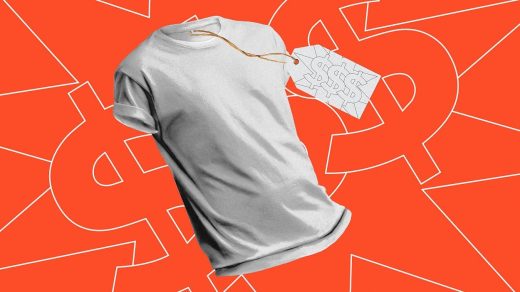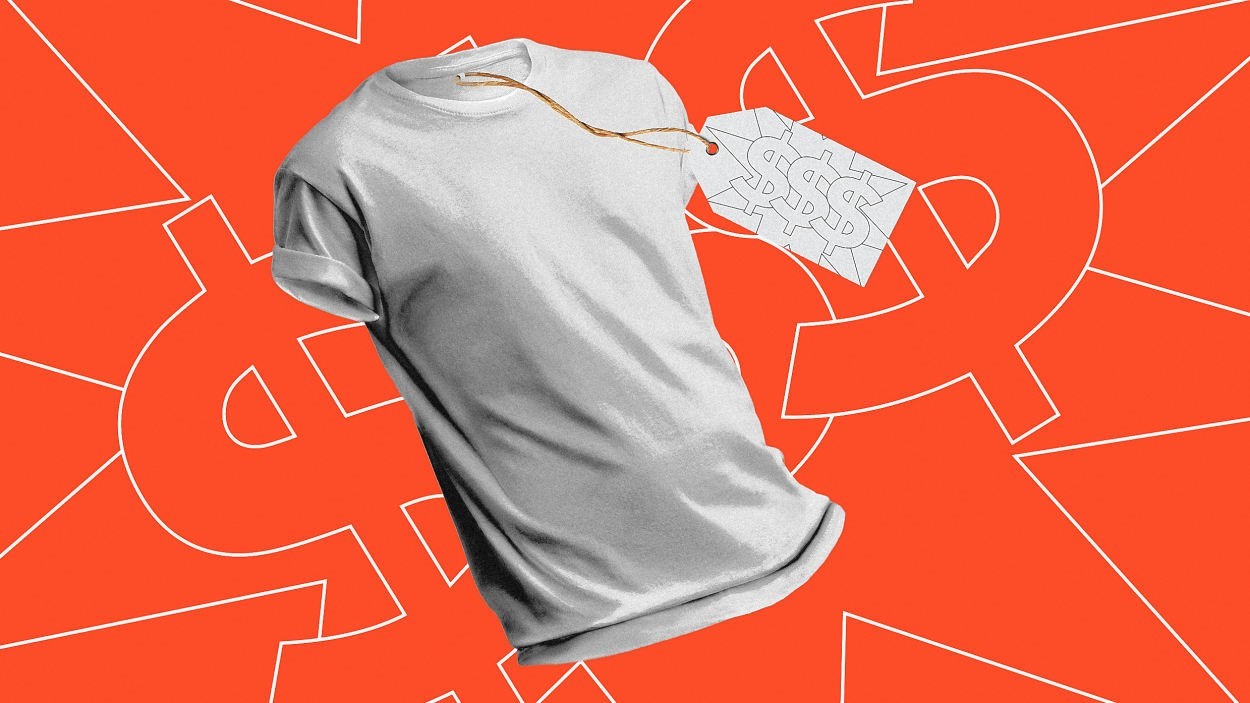Why are sustainable clothes so expensive?
As our planet hurtles toward a climate catastrophe, many of us are trying to figure out how to shop more sustainably. But when it comes time to buy a new article of clothing, it’s easy to feel sticker shock.
We know clothes from eco-friendly brands like Patagonia, Eileen Fisher, and Reformation are better for the planet. But can we really afford to spend $289 on a puffer hoodie, $378 on a cashmere sweater, or $278 on a midi dress? And why are these clothes priced so high in the first place? What are we really paying for?
These are questions that consumers are asking every day. Just ask Daisy Christophel, the social media manager at Remake, a nonprofit that advocates for a more ethical fashion industry. On a weekly basis, people comment on the organization’s social media feed that they want to break their fast-fashion addiction, but they keep going back to Shein because eco-friendly alternatives are so much pricier.
Christophel likes to turn the question around and raise the possibility that perhaps it’s not that ethical brands are so much more expensive but rather that fast fashion has warped our sense of how much we should be paying for clothing. “Fast-fashion brands have built incredibly damaging supply chains to get prices to be as low as they are,” she says. “They’re exploiting workers and churning out more clothes than the planet can sustain.”
The real cost of fashion
In 1960, American households spent more than 10% of their income on clothing and shoes, what would amount to roughly $4,000 today. The current figure is just 3.5%, or less than $1,800. But while the average person bought 25 garments annually back in 1960, shoppers today snap up 70 garments per year on average.
How is it that we spend half as much as we did in the past for nearly three times as many clothing items? The answer has everything to do with fast fashion. This business model emerged in the 1980s with pioneers like H&M and Zara building global supply chains to churn out the latest trends. By using overseas factories that pay workers poorly and utilizing cheap synthetic materials, they were able to drive down prices.
This approach has proved incredibly profitable: The parent companies of both H&M and Zara are now among the most successful businesses in the fashion industry. And while these companies have found ways to reduce the cost of making a garment, their profit margin is usually upwards of 10% on every article of clothing they make, which is often higher than their more sustainable counterparts. By producing billions of garments annually, fast-fashion giants make billions of dollars in profits.
The fast-fashion business model is so lucrative that half a century later it’s now the norm. Brands ranging from Target to Gap to Abercrombie & Fitch use supply chains modeled on fast fashion. All the while newer companies like Temu and Shein are manufacturing at volumes and speeds we’ve never seen before.
But increasingly there are also fashion brands that are going against the grain of the industry and choosing to manufacture sustainably and ethically. Some are luxury labels, like Maria McManus and Another Tomorrow. Others are more accessibly priced, including Pact, Nisolo, Printfresh, and Amour Vert. But if you’re used to shopping fast fashion—and the truth is, we all are—these clothes will be double, or more, what you’re used to paying.
So why are ethically made clothes so expensive? To learn more, I turned to Amanda Lee McCarty, who spent two decades working in fast-fashion companies ranging from Urban Outfitters to Modcloth. She quit to become an ethical fashion advocate and the founder of Clotheshorse, a podcast that decodes and demystifies the fashion industry. She lays out exactly where conscious brands refuse to cut corners and compromise on manufacturing.
The Labor
The fast-fashion industry was built on finding low-cost factories overseas, and over the decades the price of clothing manufacturing has trended downward. Ultimately, garment workers bear the brunt of this. Only an estimated 2% of all garment workers earn a living wage.
Consider the plight of workers in Bangladesh, a hub of fashion manufacturing. Until last year, the national minimum wage was $72.50 per month, which is a pittance of the $462 experts believe is a reasonable living wage. (After protests, the government raised it to $113 starting this year.)
McCarty says that at fast-fashion brands the cost of labor is so low that the expense ends up making just a small fraction of the total cost of a garment. In her experience, about 70% of the cost goes into fabric, which means the other 30% goes to transportation, duties and taxes, and, finally, workers’ wages. In other words, if a brand spends $10 to manufacture a dress, only $1 may go to the worker. Brands do this by pressuring factories to find ways to pay workers even less than the legal minimum wage in these developing countries.
“Large brands will threaten to take their business elsewhere if a factory doesn’t find a way to get to the low price they want,” McCarty says. “Factories might cut workers’ pay when they make mistakes, for instance.”
Ethical brands prioritize paying workers fair wages, which often means going beyond legal requirements and setting their own standards for what counts as a living wage. Nisolo and Able source factories around the world that have good working conditions, and they publish the lowest wages they pay. They also work with third-party auditors to ensure these factories continue to operate ethically. “When you buy from these brands, more of your money is going to workers,” McCarty says.
But higher wages also mean that the price of the garment goes up. An Able T-shirt, for example, costs $48, and a pair of Nisolo boots costs $250. It’s more than you’ll pay at Target, but you know that the workers who made your products could feed their families.
The Fabrics
The quality of clothing has declined significantly over the past few decades, as fast fashion has raced to the bottom to offer lower and lower prices. As a buyer for various fast-fashion brands, McCarty was regularly told to find a way to make a garment cheaper. Since fabric makes up so much of the cost of a garment, the quickest way to reduce the pricing was to reduce the quality and amount of fabric they used.
“This meant removing pockets and zippers,” she says, explaining that these additional bits of material can increase the price of a garment by a few cents, which adds up when you’re operating at enormous volumes. “But a surefire way to make the garment cheaper was to use a lower-quality, crappy fabric,” she says. “We knew these materials would tear and pill easily, but it was all about getting the cost down.”
Today, an estimated 60% of clothing is made from synthetic materials (plastic textiles derived from fossil fuels) because they are so inexpensive. Garments made with low-quality fabrics are not made to last, and therefore customers tend to discard them quickly, which leads to other problems. Unlike organic fabrics like wool and cotton, synthetics don’t biodegrade, so they will stay in our landfills forever and pollute our waterways with microplastics.
Many sustainable brands opt for better, more durable fabrics, including natural fibers. But this is costly. Cotton costs 25% more than polyester. And if you buy certified organic cotton, which is less polluting to the planet, you’re going to pay up to 30% more than traditionally farmed cotton.
This is exactly what Pact does. It makes most of its clothing from organic cotton that is also carbon neutral and fair-trade certified. Even in its activewear, it uses fabric that is 90% organic cotton with 10% elastane for stretch. “These fabrics are more expensive for the brand to purchase,” McCarty says. “But they are also more durable. So you’ll get more wear from the garment.”
The Sizing
Have you noticed that clothes don’t fit as well as they used to? McCarty says this isn’t a mistake. When she first started her career two decades ago, each garment would go through several fittings with models to make sure it fit well and looked good on the body. But to get products out more quickly and at lower cost, brands started skipping these fittings. “We would just hope for the best,” she says. “But this meant that large volumes of clothes would be returned because they didn’t fit well. We just priced these returns into our bottom line.”
Sustainable brands tend to be smaller companies with leaner margins, so they simply can’t afford to allow entire collections to go to waste because they don’t fit. “An error like that could be devastating for a small brand,” McCarty explains. So these brands take a more old-school approach to fitting, trying each garment on a fit model, then making several adjustments before it is mass produced. When it comes back from the factory, they’ll likely do another quality check.
As a result, the final garment will fit better and be more flattering. This is how the ethical underwear brand Underprotection fits so much better than undies you might get from, say, Target or Victoria’s Secret. The many fit sessions and quality controls mean you’re less likely to return the items you buy, and you’ll get more wear out of them.
The Volume
This brings us to the final reason sustainable brands cost more. Most ethical, eco-friendly brands are working hard not to overproduce. Rather, they make just enough to meet demand. This means they are making products in small quantities, which tends to be more expensive because factories offer discounts for bulk orders.
Conversely, fast-fashion brands tend to manufacture tens of thousands of pieces for each style to maximize on these discounts. McCarty says that many brands assume that a portion of these garments will be thrown out. And given that it can cost as little as $3 for a brand to manufacture a T-shirt or $10 to make a dress, it can afford to take these losses and simply add a few dollars to the price that you pay as the consumer. “The price per garment is so low when you’re making at these volumes, that even if you know you won’t be able to sell hundreds, or even thousands of these clothes, the math still works,” she says.
The absurdity of extracting natural resources from the earth and making workers manufacture garments that will never even be worn encapsulates what is wrong with the fashion industry. Sustainable fashion brands are deliberately trying to push back against the status quo and find ways to operate that are more respectful of the earth and of workers. And all of this comes at a cost.
As more consumers gravitate toward sustainable brands, those brands will be able to manufacture at higher volumes, and, perhaps, lower their prices slightly. But eco-friendly clothing will never be as cheap as fast fashion.
McCarty says that it’s important to think beyond price, to the value you’re getting. Ultimately, while sustainable brands charge more, you’re getting a better product that will last longer. “How many fast-fashion outfits have you thrown out after a few wears because [they] tore?” she says. “The fact is, fast-fashion brands are in the business of ripping you off. Buying slow fashion means getting an article of clothing that is well made and designed to look good on you. When you consider the cost per wear, you’re actually getting a better deal from these sustainable brands.”
(35)



